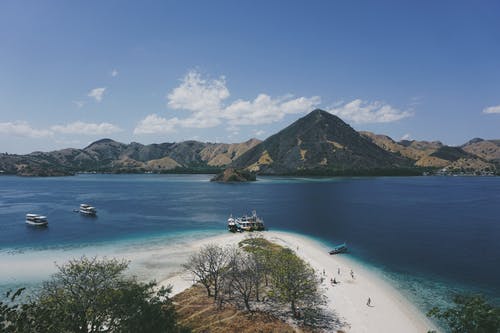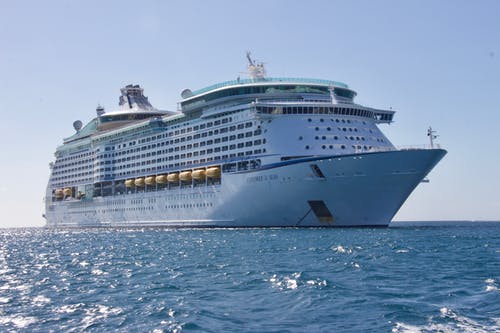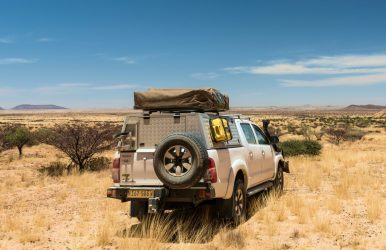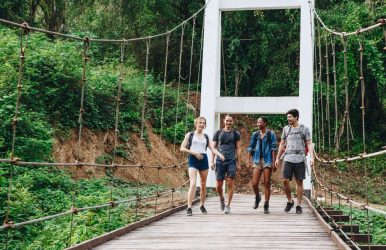THESE Are the Best Southern Africa Off-The-Beaten-Path Adventures | Travel Guide
BY Sibashree Oct 4, 2019
In Afrikaans, a kloof is a narrow mountain river valley or a canyon. And South Africa off-the-beaten-path adventures have followed a course parallel to the antics of European and American canyoneering enthusiasts. Kloofing is following a mountain river from its beginnings down through waterfalls, rapids, whirlpools, hiking, and climbing your way in between swims. It’s a bit like high diving, hiking, and being put through a spin cycle—all at once. If you are still confused, I am referring to Southern Africa and its off-the-beaten-path adventures. Do you want to know about more hidden gems in Southern Africa? Keep reading! THESE Are the Best Southern Africa Off-The-Beaten-Path Adventures Southern Africa, with its eclectic culture, has been attracting tourists to its iconic monuments and natural landscapes. Here are some off-the-beaten-path adventure spots you must add to your itinerary list. 1. Kloofing Near Cape Town In the mountains behind Betty’s Bay, a short drive from Cape Town, are South Africa’s two best kloofing day trips. Choose between the regular route, where you’ll have to leap 20 feet off a waterfall into the pool below, or Suicide Gorge (heads up: this means a leap of 60 feet). To date, no one has been hurt seriously on a kloofing trip. However, if you’re subject to vertigo and aren’t at least halfway fit, then don’t do it. The company Day Trippers will provide guides, wetsuits, lunch, transport, and moral support. 2. Lesotho on Horseback The mountain kingdom of Lesotho, in east-central South Africa, serves up stone villages atop remote hillsides. Villagers, called Basotho, live draped in blankets and robes, almost like ancient Greeks. Shepherd boys sit on the slopes, playing flutes. Vultures and eagles cruise overhead. In Lesotho, the horse remains the chariot of choice, and this is how you’ll want to get around as well. Semongkong Lodge, near Maletsunyane, southern Africa’s highest waterfall, offers horseback treks for several days. You’ll stay in timeless Basotho villages and ride some of the subcontinent’s steepest terrain. The Basotho ponies, schooled in a special “tripling” gait, are tough, sure-footed, and afraid of nothing. A tip: Book a trek that coincides with Semonkong’s horse races. They’re wild spectacles involving carefully nurtured thoroughbreds, child jockeys, and epic bouts of drinking. 3. Hike Chimanimani To Make The Most Of Southern Africa Off-The-Beaten-Path Adventures As South Africa fills with travelers, more and more are heading into Zimbabwe, and several areas have been developed for hiking, fishing, riding, and other types of tourism. But the mountainous Eastern Highlands, east of Chimanimani in southern Zim, are hardly developed at all, and that’s their appeal. Besides, this area, part of the Lebombo Mountain range that marks the border between Zimbabwe and Mozambique, provides year-round cool relief from the heat of the plains below. For the serious hiker, a stiff climb-in is rewarded by an upland paradise of high pastures, waterfalls, forests of flowering protea trees, and caves large enough to sleep in. Because the water up here is pure and drinkable, you can live here for days if you bring enough food with you. The only downside: Don’t cross over to the Mozambique side of the mountains, as old land mines from that country’s now-defunct civil war are still scattered on the range’s eastern slopes. Stick closely to the maps (available in Chimanimani village). 4. Learn Polo-Cross Hugely popular in Zimbabwe and a growing equestrian sport around the world, polo-cross means falls, body crunches, and glancing blows with the lacrosse stick. But those with a go-smack-em attitude and sufficient riding experience can learn this fast and highly skilled equestrian sport on trained horses at Mopani Lodge, near Kwekwe in the Midlands area. Relax between sessions by riding out on the ranch (which has a cross-country course if you still need an adrenaline fix) or just by sunning at the pool. And because of the favorable exchange rate, what would be an extremely expensive riding holiday anywhere else in the world has become one of adventure tourism’s best bargains. 5. Hunt with Bushmen If you’re after Southern Africa off-the-beaten-path adventures, you can’t do any better than traveling with the Ju’Hoansi. Ju’Hoansi is the last Kalahari Bushmen clan to pursue the traditional hunting and gathering lifestyle. They’ve decided to open to small-scale tourism in their remote Namibian locale. You’ll camp near the Ju’Hoansi village of Makuri, go hunting with the men, and gather with the women. This is no theme-park experience: If the hunters stick an animal with an arrow, you may have to track it for up to two days and then carry out your share of the meat. If you love hunting, you can take the best hunting bow with you. You must also carry your own water and food. Don’t just spend a couple of days here: Allow at least a week for the people to become comfortable with you. If you’re lucky, they may also invite you to attend a trance dance, at which miraculous healings often take place. 6. Dune Boarding The seaside town of Swakopmund, where the Namib desert falls into the sea, has become southern Africa’s dune-boarding capital. You’re driven out to the foot of a mountain-sized sand dune, given a large oblong sheet of hardboard, some furniture polish, a pair of heavy industrial gloves, and some welding goggles, and the next minute you’re flying almost vertically downward. It feels suicidal; even on the easiest descents, the board can pick up speeds of 60 or 70 km (about 43.5 mi)/hr. Steeper ones are much faster. Then you graduate to jumps, finally ending the day with the “Knucklegrinder,” an 800-foot whoosh down to a hard gravel plain. 7. Ride the Namib It’s easily one of the most spectacular rides in the world: You’re galloping through the Namib Desert, the world’s oldest, surrounded by 2,000-foot-high, blood-red sand dunes. Thousand-year-old plants that resemble exploded cabbages grow on gravel plains that see rain once in a century. Lonely canyons echo the barking shout of baboons and the nighttime cough of leopards. Then, suddenly, green oases spring up, overgrown with camelthorn and tamarisk trees, where herds of desert antelope gather in the shade. Continue to sun-blasted mountain ranges where ice-cold springs bubble straight from the rock. Trot through this barren wilderness with Reit Safari, which offers 10-day rides on Namibian Hanoverians (German horses) and rehabilitated mustangs, starting on the mountains west of Windhoek, Namibia’s capital, and ending in the ocean of the aptly named Skeleton Coast. 8. Earthwatch Cheetah Project The lion really can lie down with the lamb—or at least the cheetah can. So, the biologists of this Earthwatch cheetah conservation project believe, anyway. Your job: to assist in live-capturing and radio-tracking cheetahs and other big cats on the wilderness ranches of central Namibia—the last place on earth where cheetahs still exist in reasonable numbers. Local ranchers used to shoot them on sight. However, now many are cooperating with the study, which seeks to prove that cats only rarely hunt livestock if their natural prey is readily available. You, the paying volunteer, have the satisfaction of contributing directly to the conservation of these cats while at the same time experiencing the adventure of chasing after and handling them. 9. Bike the Botswana Pans Why would anyone want to bike through the Makgadigadi Pans—two vast, shallow expanses of mud? In the scorching Botswana summer, they fill with rain, releasing millions of tiny brine shrimp, which in turn attract breeding flocks of pink flamingos. In the dry winter, they bake to a hard white crust. A perfect surface across which to go roaring on a quad bike. So wide are the pans that when out in the middle of them, you can’t see the “shore.” And the stars in this part of the Kalahari are unrivaled. From Jack’s Camp, a luxurious place at the edge of the pans. You take quad bikes out to a table set out in the middle of the emptiness to find dinner laid and ready. By day, you go walking, look at the game, and pick wild foods with a Bushman guide called Cobra. If you go during the sweltering summer months, you can’t quad bike the pans (too glutinous). However, you do see the flamingos. Further, if you’re lucky, you might see the eastern Kalahari’s summer zebra migration. 10. Deep Kalahari If you have at least two weeks to explore Southern Africa off-the-beaten-path adventures, hire a 4×4 and blast off into southern Africa’s most remote country. The bigger-than-Switzerland Central Kalahari Game Reserve and the Aha and Tsodilo Hills. This is rugged driving on some of the toughest tracks in Africa; you must know what you’re doing in a 4×4. You must carry all the fuel and supplies. And if you get stuck, well, suffice to say it’s best to go in a convoy of two vehicles. Highlights of this once-in-a-lifetime trip include the desert lions of Deception Pan. The Bushmen communities at Molapo and Xai-Xai (where you can go out with the hunters). The stalactite-filled caves of Drotsky’s Caverns and the ancient rock paintings of the Tsodilos. When you emerge at Shakawe at the northern edge of the Okavango Delta, you’ll forget what civilization looks like. Final Words on Southern Africa Off-The-Beaten-Path Adventures With dense vegetation, rugged cliffs, and fascinating wildlife, the Southern Africa Off-The-Beaten-Path adventures promise an unforgettable experience. These trips are also about learning about various fascinating cultures and respecting nature. So, if you plan to visit Southern Africa soon, you can visit any of the places I have discussed here. Don’t forget to share your experience once you come back! Happy journey!













